Pioneers of Sustainability
For two dozen years, Rice professors Ron Sass and Frank Fisher stood side by side in rice paddies in the United States and China, blending their expertise to tackle one of the world’s most pressing climate challenges: methane emissions. Sass, a polymath with a background in chemistry and ecology, brought a dynamic career that spanned diverse research areas — from crystallography to mollusk calcification to optical studies of muscle structure — before turning to climate change. Fisher came to Rice with a specialty in invertebrate zoology and a particular interest in parasitology. Although he grew up in the Midwest, Fisher became fascinated by the wetland environments of the Texas Gulf Coast. Together, Sass and Fisher pursued their curiosity and interest in the environment. Applying their complementary skills, they uncovered practical methods to reduce methane emissions from rice fields, laying the groundwork for innovative climate research and mitigation strategies.
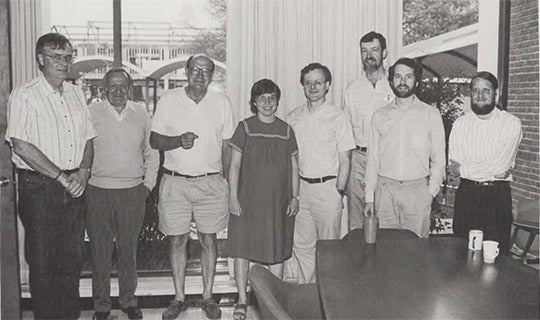
“Frank Fisher was the inventor, the really creative mind behind building things and finding ways to measure things,” said Jennifer King ’94, a professor of geography at the University of California, Santa Barbara and former undergraduate researcher with Sass and Fisher. “Ron Sass was always thinking about the big picture, and he was very interested in how to analyze data. They complemented each other well and were a lot of fun together.”
Although they were very different in personality and scientific approach, Sass and Fisher worked in collaboration to innovate climate studies. In the early 1990s, climate science was still evolving. The greenhouse effect was well known, but most of the focus was on carbon dioxide. Methane, however, is 28 times more potent at trapping heat in the atmosphere than carbon dioxide, contributing to rapid global warming.
Methane emissions arise from both human activity and natural sources, with wetlands — including flooded rice paddies — standing out as the largest natural contributors. Water blocks oxygen from reaching the soil in these soggy environments, creating the ideal conditions for anaerobic methane-producing bacteria to thrive. Research at the time revealed that methane levels depend on factors like soil type and agricultural practices. This variability prompted Sass and Fisher to investigate whether these factors could be controlled to reduce emissions. “If such factors can affect methane output, would it be possible for rice growers to change their planting habits to reduce it?” Sass asked in 1990.
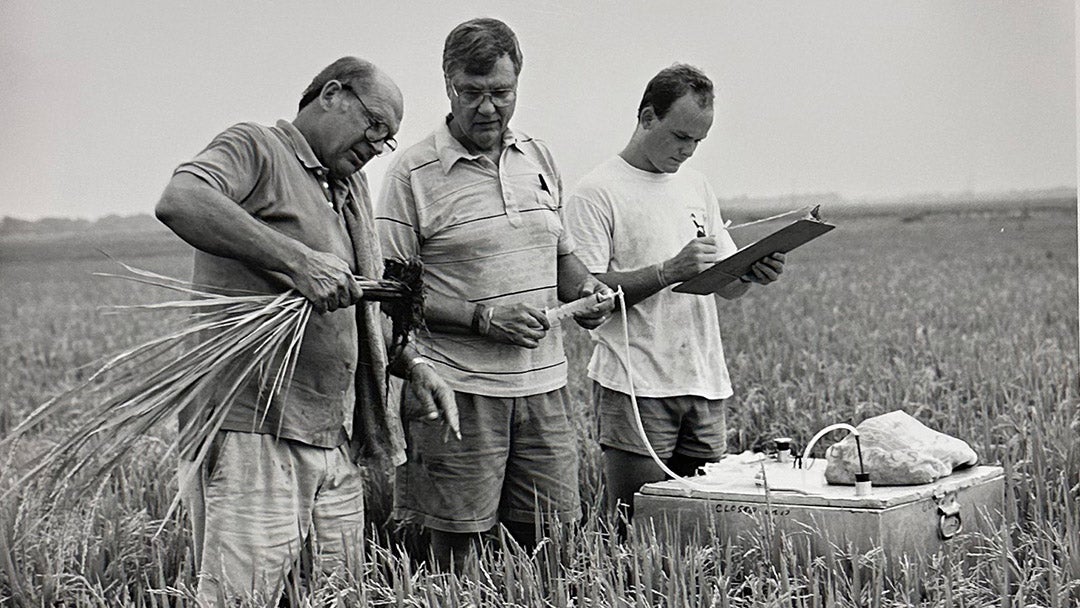
The team had already uncovered a partial answer thanks to an unexpected twist of fate. While refining estimates of methane production and studying emission processes in two test fields near Beaumont, Texas, nature intervened in the form of 1989’s Tropical Storm Allison. Not to be confused with the infamous Allison that drenched Houston in 2001, the 1989 storm caused flooding that breached levees around one of the test fields. In an ironic twist, the flooding drained the normally flooded rice field. Sass and Fisher found the field still produced a healthy crop, but its methane emissions were noticeably lower than those from the field that had remained flooded. In their subsequent paper, they noted, “Lower methane emissions from this field may be due to … aeration of the soil and other conditions which resulted from premature field draining.” Thanks to the capriciousness of Texas weather, Sass and Fisher were onto something big — field drainage could be a key factor in reducing methane emissions.
The pair recognized the need to broaden their research beyond Texas. As Sass observed in a 1990 interview, “This is a global problem, but you have different problems in different parts of the world. It is a very complex process, modified by the local environment.” Fisher echoed this sentiment in 1997, expressing their goal to “predict methane emissions from rice on a worldwide basis.” Recognizing China’s role as one of the world’s largest rice producers, they expanded their studies to include rice paddies there, aiming to better understand methane emissions on a global scale.
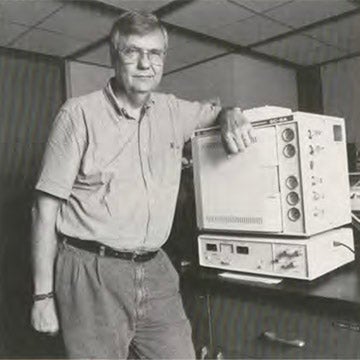
This research was as challenging as it was rewarding. To collect massive amounts of data, Sass and Fisher spent years in rice fields, measuring methane emissions under different conditions. The work was, of course, physically demanding. “Rice growing season in Texas was from late April to mid-August,” said Yao Huang ’97, a former Ph.D. student of Sass’ and professor of ecology at the Chinese Academy of Sciences’ Institute of Botany in Beijing. “Graduate students usually took a field trip once a week, and it usually took us two to three hours to finish our field observations.”
To avoid the heat and humidity of Texas summers, lab members would leave for the field early in the morning and come back in the afternoon — often with a cooler full of samples to analyze. “The samples might come on a Greyhound bus, and we’d have to go to the bus station and pick up the samples in a big cooler,” King recalled. “Or if Frank Fisher was out in the field, he’d bring samples back with him. These syringes with gases in them needed to be analyzed as soon as possible. When they arrived, we would drop everything and start running samples on the gas chromatograph.”
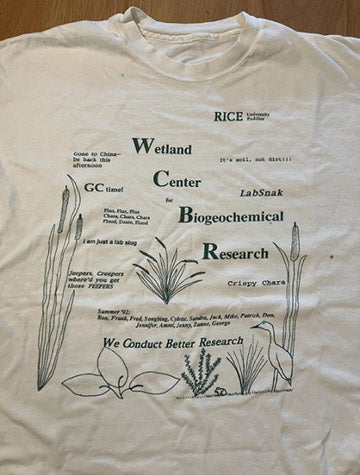
Sass and Fisher made it a priority to foster a sense of community and fun within their group, teaching students not only how to conduct research but also how to work collaboratively as part of a team. At the students’ urging, they named the lab the Wetland Center for Biogeochemical Research (WCBR) and even tasked the undergraduates with writing a proposal to fund lab t-shirts. The WCBR occasionally visited Texas rice fields, including both graduate and undergraduate researchers, in what was described as a highly collaborative environment. King still has her lab t-shirt from the summer of 1992, which includes the names of all the researchers and humorous quotes. One quote reads, “Gone to China, be back this afternoon,” referencing a funny anecdote about Fisher. Known for his early morning starts, Fisher would write that note on the chalkboard before leaving for China, Texas, a small town near Beaumont and the test fields. The quote also doubled as a pun, reflecting the lab’s frequent trips to China, the country, as well as its active efforts to host exchange students from there.
Huang was one of the exchange students, working in the lab from 1994 to 1997. He quickly recognized the groundbreaking nature of Sass and Fisher’s work, describing them as “world pioneers” in methane-emission studies. Reflecting on his time with the team, Huang shared a meaningful interaction: “They were open, full of encouragement … I learned a lot from (them), including perspective in science research and guidance to graduate students.”
Their hard work paid off. After years of data collection, Sass and Fisher identified small factors that could lead to a significant reduction in methane emissions. They discovered that draining rice fields once during the growing season aerated the soil, reducing methane emissions by 50%. Draining the fields three times could reduce emissions to nearly zero. By carefully managing the drainage, fertilizer and soil conditions, they were also able to increase rice yields by 5-10%. This crucial finding later informed global climate models and mitigation strategies.
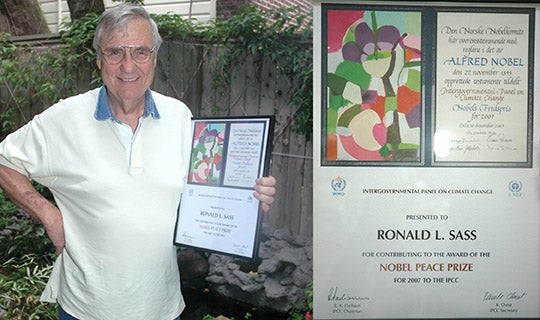
Their research on methane emissions gained international recognition and put Sass at the forefront of the climate change movement. This recognition helped pave the way for Sass’ involvement with the Intergovernmental Panel on Climate Change (IPCC), where he led the committee that studied methane emissions from croplands and co-authored guidelines on national greenhouse gas inventories — work that helped the IPCC and former Vice President Al Gore win the Nobel Peace Prize in 2007.
Sass and Fisher’s contributions to climate science have left a lasting legacy. Their pioneering research not only laid the groundwork for future advancements in the field but also stood at the forefront of a new way of thinking about environmental scholarship. “Today, we talk about Earth System Science as a given — of course, we study the whole system rather than only studying individual parts,” said King. “But Ron and Frank were doing this at a time when that was not the way most people thought about things.”
Their influence extended far beyond their research findings. By fostering an environment of collaboration and mentorship, Sass and Fisher empowered young researchers to tackle some of the world’s most pressing environmental challenges. Many of their students are now leaders in the field, applying the lessons they learned to projects and initiatives across the world.
-Sage Lee ’26
This work was made possible with support from the Fondren Fellows program.
